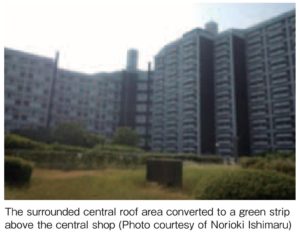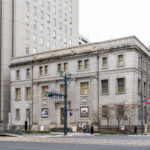5 Pains Accompanying Redevelopment and Reconstruction
As discussed repeatedly, it was not easy to redevelop the city. In the area designated as roads, parks, and the riverbank greenbelts under the “Hiroshima Reconstruction City Plan,” clusters of illegal housing and shops had been constructed by those who had lost their homes. The harsh reality was that the first step in reconstruction had to begin with the compulsory removal of the illegal buildings (in some locations).
For example, the Nakajima district, which would later go on to become the Peace Memorial Park, had a dense concentration of houses, shops, and recreational facilities before the atomic bombing. Being within 500 meters of the hypocenter, it suffered great damage. After the war, that large area was designated as a space for a park, and the residents were forced to relocate to other places. The residents in this area were not able to rebuild their communities as they had no choice but to live separately in different locations after the land readjustments.
The land owners, entitled to receive land at the time of the land readjustment, were able to start new lives on their new property, but those without such foundation were, in many cases, left with no choice but to live in illegally-built housing. As construction of the park progressed, those who lived in these illegal houses were evicted one after another.
From the Meiji period up until the atomic bombing, the Moto-machi district was the embodiment of a military city with many military facilities. As the Moto-machi district was also located a short distance, roughly one kilometer from the hypocenter, it also suffered devastating human and physical damage. In the war damage reconstruction plan, the western side of the former military site in Moto-machi was to be used mostly for park land. However, in measures to counteract the lack of residences, the city and prefectural governments and the Housing Corporation built emergency housing in this area.
By 1949, a total of 1,800 public homes had been built in the Moto-machi  district. Still, there was a desperate need for housing, resulting in a barrage of illegal constructions along the banks of the Ota River by those without land. Later, the old public housing was replaced to mid-rise housing complexes. The construction of mid-rise housing complexes did not lead to the removal of all of the old and illegal structures from the densely packed housing clusters. Redevelopment of this area was the biggest task in the final stage of the war-damage reconstruction project in Hiroshima.
district. Still, there was a desperate need for housing, resulting in a barrage of illegal constructions along the banks of the Ota River by those without land. Later, the old public housing was replaced to mid-rise housing complexes. The construction of mid-rise housing complexes did not lead to the removal of all of the old and illegal structures from the densely packed housing clusters. Redevelopment of this area was the biggest task in the final stage of the war-damage reconstruction project in Hiroshima.
In March 1969, the Moto-machi district was designated by the national government as an area to be developed under the Residential Areas Improvement Act and the redevelopment project in the district started. Along the riverbanks, forced evictions from the illegally built homes were conducted as the greenbelts were being developed, and the Moto-machi and Chojuen high-rise apartment complexes were built by the residential area improvement project. The mall in the center, the rooftop gardens, and the piloti were also constructed in addition to housing. Today, the high-rise apartment complexes in Moto-machi have become historic structures that tell the story of Hiroshima’s reconstruction process.
Inquiries about this page
Hiroshima Prefectural Office
Street address:10-52, Motomachi, Naka-ku, Hiroshima-shi, Hiroshima-ken, 730-8511
Tel:+81-(0)82-228-2111




